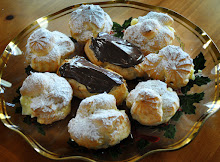Wednesday, September 11, was our day to do a walking-tour of Cologne. The center of the city is dominated by the Cologne Cathedral. Wherever you go, you can see its towers piercing the sky. The square in front of it is lively, full of artists and musicians. We walked around the cathedral, but did not go inside.
We walked by the Cologne Philharmonic Hall, where there were guards keeping people from walking on the red brick plaza in front of the building. Our tour guide explained that noise from people walking, or noise from skateboards, can be heard in the hall, so no one is allowed to walk on the square during a performance. The picture below shows the Philharmonic Hall on the left, the red brick plaza in front, and behind it all, the Cologne Cathedral. You'll notice - NO ONE is walking on the red bricks.
A prominent monument, between the Cathedral and the Rhine, is the statue of Kaiser Wilhelm II, mounted on his horse. Wilhelm II was King of Prussia and the last German emperor, who reigned from 1888 until the revolution of 1918.
The Wilhelm II statue stands near a bridge, crossing the Rhine River. Most of Cologne's bridges are painted the shade of green shown in the picture below. It is known as Cologne Green or Adenauer Green. Konrad Adenauer (first Chancellor of West Germany from 1949 to 1963) wanted this patina-like green color custom-mixed and used on all of Cologne's bridges. We were told that the bridges under the control of the city are not allowed to be painted any other color, even to this day.
A fun part of the city is known as the Fish Market. Despite its name, this area is no longer a place to buy fish, but a charming collection of houses, inns and pubs, dating back to the Middle Ages. The area was, indeed, the place where the fishermen of old brought and sold their fish. The Fish Market buildings survived the bombings during World War II, unlike many other buildings throughout the city.
The two figures in the photo below, which stand in the Fish Market, are known as Tünnes and Schäl. Tünnes represents the good natured commoner, with good sense and cleverness, while Schäl represents the upper-class. It is considered good luck to rub the nose of Tünnes.
The city center boasts a number of fountains and up-scale shops, including the 4711 Eau de Cologne store, in the location where that scent was first formulated. Eau de Cologne was originally created (1789) by Johann Maria Farina, an Italian living in Cologne.
We returned to the ship, which then took us not far up the Rhine, to the city of Bonn. Bonn is a beautiful city. Although it is large, it is a quiet city, with stately homes and government buildings. Our tour guide told us that, although Bonn is a university city, the students prefer to go to Cologne for their night-life, leaving Bonn peaceful. Bonn was the capital of West Germany from 1949 to 1990, and the seat of government (but no longer capital) of the reunited Germany until 1999.
I didn't get any good photos of the city, since we did not do a walking tour. We rode through the city, by bus, in the evening, as we headed to the Marksburg Castle where we had dinner and were entertained by minstrels and a very funny jester. It was 10:30 or 11:00 before we were back on board the Ruby, and we were very tired.
 |
| Our destination - the Marksburg Castle - sits atop the hill. |
CLICK HERE NEXT (RHINE GORGE)



































































